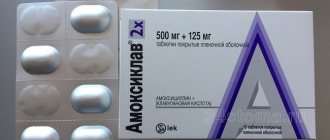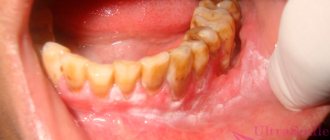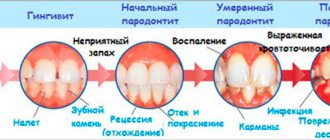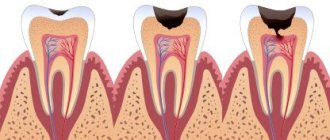Pathological changes in the oral cavity, as well as diseases of the oral mucosa are one of the symptoms of the presence of the immunodeficiency virus in the body. However, one should not think that the presence of dental problems may indicate infection with the immunodeficiency virus. To understand how oral diseases are related to HIV infection, it is worth talking in more detail about the immunodeficiency virus and its vital functions.
What is HIV? What is HIV infection
The human immunodeficiency virus, or HIV, was identified and described relatively recently. Invading the human body, it primarily affects macrophage cells and T-lymphocytes, which are responsible for recognizing and destroying hostile bacteria. Thus, the body's immune barrier loses its ability to resist both external bacterial attacks and internal opportunistic flora.
The immunodeficiency virus is transmitted exclusively through sexual contact or through direct contact of a healthy body with infected blood. Transmission of the virus through household or food contact is impossible.
HIV infection is a slow-onset disease caused by a virus and occurs against a background of suppressed immunity. It can take years from the introduction of the virus to the clinical manifestations of the disease. During this entire period, the virus does not manifest itself in any way, and its presence can only be diagnosed using a laboratory method.
Kaposi's sarcoma
Kaposi's sarcoma, or KS, is a type of cancer that causes blue or purple bumps to grow under the skin in the mouth, nose, and anus. Symptoms of Kaposi's sarcoma may include:
- difficulty eating or swallowing;
- nausea;
- vomit;
- abdominal pain;
- unexplained cough;
- chest pain;
- swelling of the limbs.
People living with HIV have a much higher risk of developing Kaposi's sarcoma than people without HIV. However, KS is becoming less common now that effective treatments for HIV are available.
Treatment for people with CS depends on the number of tumors, their location and the state of the immune system. Treatment options include:
- antiretroviral therapy;
- chemotherapy;
- radiation therapy.
HIV infection of the oral cavity and its causes
Inflammatory processes in the mucous tissues of the oral cavity are one of the first symptoms of virus activation. This is due to the peculiarity of the structure of the oral cavity and its constant contact with the aggressive external environment. Most often, the mucous membrane is affected by the herpes simplex virus, Candida fungus, Epstein-Barr virus, and papillomaviruses. Bacterial infections are caused by streptococci and staphylococci, which are no longer contained by local immunity. In conditions of immunity suppressed by the virus, periods of remission become shorter, and inflammatory processes are acutely progressive. Timely prescribed additional studies make it possible to correctly prescribe a course of maintenance therapy, since diseases of the oral mucosa are not directly a symptom of HIV infection.
Based on their suspected association with HIV, oral infections are divided into three groups.
Group 1 includes pathologies most closely associated with the immunodeficiency virus:
- candidiasis, colloquially “thrush”;
- hairy leukoplakia (changes in the mucous membrane of the tongue);
- HIV gingivitis (acute inflammation of the gums);
- HIV periodontitis (periodontal inflammation);
- Kaposi's sarcoma (a specific neoplasm on the hard palate of the oral cavity);
- non-Hodgkin's lymphoma.
The 2nd group of diseases includes lesions to a lesser extent, associated with symptoms of HIV infection:
- thrombocytopenic purpura (multiple hemorrhages);
- pathology of the salivary glands;
- viral infections (herpes).
Group 3 includes diseases that often occur with HIV infection, but are not associated with it. Below we will consider diseases from the first group, as the most characteristic of the state of immunodeficiency.
Stomatitis
Canker sores, also known as canker sores, are painful sores that can develop on the soft tissue in the mouth. They are usually small and white or gray. Doctors don't fully understand what causes canker sores, but various factors, such as damage to the mouth, stress, vitamin deficiencies, and weakened immune function of the body, may play a role in their development. Stomatitis ulcers are not contagious. People can reduce their risk of canker sores by doing the following:
- avoid and properly cope with stress;
- avoid spicy or sour foods and drinks;
- Chew food thoroughly so as not to damage the oral mucosa;
- Eat a balanced and healthy diet.
For mild stomatitis, rinsing your mouth with an over-the-counter mouthwash (such as miramistine or chlorhexidine solution) can reduce inflammation and keep the sores clean. In severe cases, your dentist may prescribe medicated ointments and mouthwash to minimize pain and promote healing.
Symptoms of HIV infection in the oral cavity
The herpes simplex virus is present in most people. The infection persists in the body throughout life and does not cause any special problems, except for rare rashes on the lips.
Herpetic gingivostomatitis
In HIV-infected people, herpes rashes are chronic with rare stages of remission. It is distinguished by blistering rashes around the mouth and on mucous tissues. When the vesicles open, painful erosions occur that develop into fairly large ulcers. The manifestation of herpes zoster and rashes in atypical places is also noticed.
Candidiasis
Candidiasis is also a common symptom of HIV infection and is chronic. Its symptoms are the same as with regular thrush, the only difference being that plaque covers most of the mouth.
Hairy leukoplakia
Clinical manifestations of the disease look like deformed mucous tissue, externally resembling folds or hairs. Localization area: lateral parts of the tongue and the inner surface of the cheeks. Painful sensations are usually absent.
HIV gingivitis and periodontitis
In this case, the infection manifests itself as acute inflammation of the gums. Starting with ordinary bleeding gums, the disease quickly develops into an acute form. With adequate treatment, tooth loss can be avoided.
Kaposi's sarcoma
This is one of the most characteristic symptoms of HIV infection in the clinical stage of manifestation. The tumor is formed from lymphatic vessels, in the mouth it is located near the root of the tongue, less often on the gums.
Treatment
The goal of treatment for this disease is suppression of the virus through active antiretroviral therapy, as well as prevention and treatment of associated syndromes and secondary infections. In our country, the following medications are used to treat AIDS:
- nucleoside reverse transcriptase inhibitors - abacavir, zidovudine, lamivudine, didanosine, stavudine, phosphazide;
- non-nucleoside reverse transcriptase inhibitors - nevirapine;
- protease inhibitors - atazanavir, indinavir, lopinavir/ritonavir, amprenavir, saquinavir, ritonavir, darunavir;
- fusion inhibitors - enfuvirtide.
Diagnosis for suspected HIV infection
For differentiated diagnosis of HIV infection from similar dental diseases, the following tests are used:
- Blood test for PCR reaction (aimed at detecting HIV).
- Immunoblotting technique.
- Linked immunosorbent assay.
- Checking immune status.
If the results are unclear, additional blood tests, as well as bacteriological studies, may be prescribed. Early diagnosis of the root cause of diseases can significantly alleviate the course of the disease.
General prevention tips
Using mouthwash and practicing good oral hygiene can help prevent mouth ulcers.
Visiting your dentist for regular checkups is a good way to prevent canker sores. Dentists can help people manage the symptoms of existing mouth ulcers and prevent the development of future ulcers. Some other ways to prevent mouth ulcers include:
- take HIV medications consistently;
- observing the rules of oral hygiene;
- quit smoking;
- staying hydrated (drinking enough water);
- avoid spicy and sour foods and drinks;
- by eating a balanced and healthy diet.
Should you hide your status?
According to the laws of the Russian Federation, the patient is obliged to notify the doctor about his HIV status. In any case, it is better not to hide such information. The doctor carries out treatment according to the general state of health - selects a treatment protocol, implantation design, and effective antibiotic therapy.
Let’s assume that the implantologist does not know about the positive HIV status and prescribes antibiotics in the same dosage as for a healthy patient. Such therapy will not have the desired effect, which will lead to inflammation, peri-implantitis, and, as a consequence, rejection of the artificial root. The doctor must be aware of the possible risk. Health information helps select a treatment regimen that will provide the best outcome for the patient.
Since immunodeficiency states are included in the list of restrictions for implantation, an HIV test is included in a comprehensive diagnosis. Therefore, hiding HIV status from the dentist is problematic.
ROOTT dental implants are the best choice for patients with HIV
ROOTT implant structures are made of biocompatible titanium with an antimicrobial surface. When the package is opened, titanium reacts with oxygen and a hydroxyapatite film is formed on the surface of the implant. Hydroxyapatite is an element that makes up bone tissue. This increases the chance that the jawbone will not reject the titanium root. The polished surface prevents the accumulation of bacterial plaque in the cervical area, which minimizes the risk of peri-implantitis.
Where to place implants
The ROOTT clinic in Moscow is one of the few dental centers in Russia that specializes in one-stage implantation with immediate loading. Our implantologists have been working with the basal protocol for many years. The presence of HIV or AIDS in a patient is not a valid reason for refusing dental implantation. Our specialists will carefully study your medical history and offer the best option for restoring your dentition. Thanks to the ability to combine protocols in one system, treating patients with a complicated medical history is not a problem for us.
What does a healthy tongue look like?
Note! The tongue of an absolutely healthy person is pink, soft with clearly visible taste buds.
A smooth groove can be seen in the center , dividing the tongue into two equal parts.
Moving your tongue while eating, drinking or talking does not cause discomfort. A small amount of white coating on the tongue is a type of normal .
Its thickness may vary depending on the time of year and the food eaten the day before. As a rule, it can be easily cleaned with a regular toothbrush.
Also, that has just begun to progress in the body can lead to the appearance of a whitish coating
- candidiasis;
- caries;
- gingivitis;
- inflammation of the gums.
Stay up to date! Separately, it is worth mentioning problems with the gastrointestinal tract.
Allergies, lack of nutrients and dietary fiber are often the cause of the appearance of a whitish or yellowish coating.
When the plaque begins to thicken and cannot be removed even with a brush, this is a reason to immediately contact a specialist.
It is likely that in this way the body signals an exacerbation of a chronic disease or infection.











